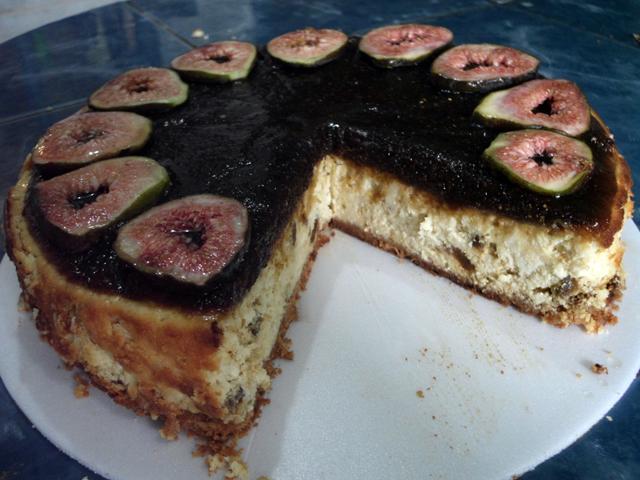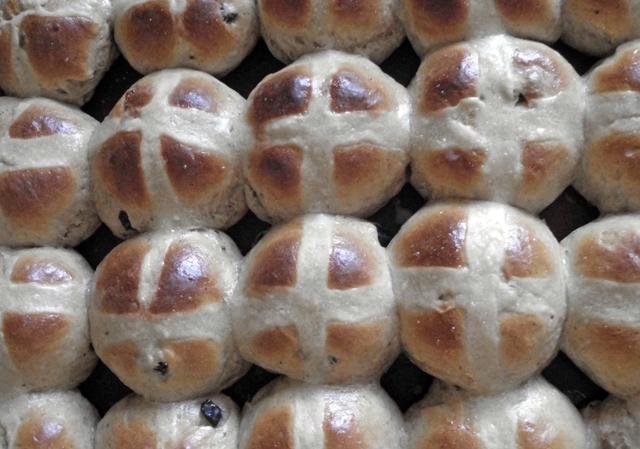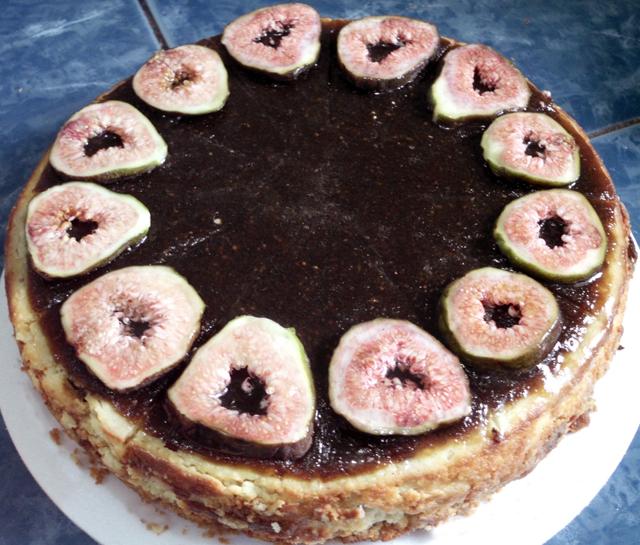-
Posts
2,383 -
Joined
-
Last visited
Content Type
Profiles
Forums
Store
Help Articles
Everything posted by Panaderia Canadiense
-
Depends on your tastes. I prefer quite a few more spices in my chai, but I got my taste for it from Nepali and Tibetan friends, who are spice lovers.
-
I've got a nice salad patch going with young Dandilion, Gallant Soldiers, Goosefoot, and Malabar Spinach in it, if that counts. They were all gifts left by the birds that I've fostered because they're so dang tasty.
-

Your Daily Sweets: What are you making and baking? (2014)
Panaderia Canadiense replied to a topic in Pastry & Baking
But of course! I'm a lazy bum and don't candy my own figs, but I seem to recall that you do. This is a dead-easy dessert provided you've got enough time to let it cool before you top it, and overnight for the topping to set up. The Cake (make a graham-cracker bottom crust for it) 500g soft cream cheese 500g pressed ricotta 1 C sugar 3-4 eggs (the number depends on the size of your eggs and how creamy vs lumpy your cheese mix is. The lumpier, the more eggs) 1 tsp vanilla 5-6 candied figs, chopped coarsely In the mixer, blend the cheeses and sugar until the mixture is looking fairly homogenous. Add the vanilla and eggs, and beat until smooth. Fold in the figs. Pour into a greased and floured springform with a graham-cracker base crust, then bake at 325 F for 1 hour. If you want this to be even figgier, you can add some of the fig syrup to the batter as well. I've found that it's not strictly necessary, though - the figs themselves will bleed into the cheese and suffuse it with figgy goodness. The Topping 7-8 candied figs, chopped coarsely About 125 mL of the syrup in which the figs were candied A bit of water 2 sachets (2 tbsp) silver strength gelatine Blend all that together until you've got a fairly thick paste. Heat over very low heat until it smooths out, then pour over the cheesecake. Allow at least 2 hours to set, preferably overnight. -
The Bastard. 12" cast-iron frypan, 100+ years old, heirloom of my great-great gran. After that, my KitchenAid K45 stand mixer and my 12" Nakiri.
-
Shel, have you payed much attention to the temperature of your oven on the batches that pull away? With my own, I find that if there's a heat spike in the last 15 minutes or so of baking, I get that pulled edge crust, whereas if the oven behaves and keeps even heat, the crusts don't do that.
-

Confections! What did we make? (2012 – 2014)
Panaderia Canadiense replied to a topic in Pastry & Baking
Fun with fondant! This is a dragon (for reference he's about 3" in diameter) for a friend's 5-year old daughter's birthday cake. There's a mermaid too - once I get the camera downloaded I'll share. -
I make a lot of Nanaimo bars - they're extremely popular here in Ecuador (I am actually beginning to regret introducing them - I make 100-unit pans, 10 or so a week). That middle layer? For less-sweet versions, I omit the flan entirely and go for an IMBC type filling - once it's chilled it sets hard and keeps that consistency for quite some time. IMBC is significantly less sweet than the traditional buttercream, and it takes sharp flavours, like passionfruit for example, extremely well. That, paired with darker chocolate in the other two layers, reduces the sweetness to a bearable level. ETA: which recipe did you find? The one that uses Graham crackers is far sweeter than the one that uses oats.
-
What's your objection to them? If it's the tooth-aching sweetness, you can counteract that by using darker chocolates, adding cocoa powder to the base mix (and using less/not white sugar there), and then modding the snot out of the middle layer….
-
Nanaimo bars, if you make them with pumpkin seeds or craisins or even real raisins (ugh…) in place of the nuts, would likely go over well. I've been doing extensive tinkering with the flavour layer, and have found that things like Piña Colada, Maracuyá (passionfruit), and Blackberry are excellent and cut the sweetness characteristic of it. Mint and Cinnamon are also quite tasty and not as sweet as one would think. If the topping chocolate is tempered, you don't even have to fridge 'em.
-
Ron 2300 from Ecuador fits this bill, but I'm not sure about the <$40 price tag anywhere but here in EC. It's aged in former whiskey barrels and has a really intriguing flavour that's closer in profile to good rye than it is to good rum.
-

Your Daily Sweets: What are you making and baking? (2014)
Panaderia Canadiense replied to a topic in Pastry & Baking
-

Your Daily Sweets: What are you making and baking? (2014)
Panaderia Canadiense replied to a topic in Pastry & Baking
Franci, what type of banana are you using? It will make all the difference - there are some varieties that are less prone to oxidation than others, and honestly the Gran Nain (Chiquita standard banana) and Cavendish (Dole/Corbana standard banana) are the worst offenders when it comes to oxidation after baking. If you're still in NYC, you should have access to "ethnic" groceries. Look for Latin American ones and ask for Plátano Limón, Plátano Burro, or Plátano Orinoco. In Filipino or Malaysian groceries, ask for Saba. And if you can find a Hawaiian grocer, cross your fingers and ask for either Iholena Lele or Maoli Popo'ulu. The latter is a huge banana considered to be the gold standard for baking as it retains its gold colour for days. -

Your Daily Sweets: What are you making and baking? (2014)
Panaderia Canadiense replied to a topic in Pastry & Baking
To celebrate the end of the lenten period, I'm making a candied fig cheesecake. Will report back on how that goes. -

Lime Shortage Affects Cocktail Bars, Restaurants...and You
Panaderia Canadiense replied to a topic in Kitchen Consumer
If the export licences for fresh fruit weren't both prohibitively expensive and torturous to obtain, I would definitely be in the market as an exporter. Just about everything citrus grows here, even some of the really obscure ones (citrons, chinottos, calmanasi, mandaquats, or bergamots, anyone? They're all in the market at the moment, and some of them are also in my marmalade pot with this season's quince). Right now Bearss Lemons are 10-12 for $1, Meyers are 5-8 for $1, and the big Malfi ones are 3-4 for $1 or free off of my friend's tree if I give him a bottle of the limoncello I use them for. The only thing that seems to be rare (although not by any means unavailable - you just have to be diligent in asking and searching) are red grapefruits. The Bearss lemon tree in my front yard says "sí!" They're peculiar to my valley, apparently - friends in other cities are amazed by what I can find in the mercado and bemoan the lack in their areas. -

Lime Shortage Affects Cocktail Bars, Restaurants...and You
Panaderia Canadiense replied to a topic in Kitchen Consumer
This is one of those times when I'm soooo glad I live in a lime-producing country. They're 20 for $1 at the mercados right now, which is a bit steep but understandable given the volcanic activity we've been having lately. (In non-ash seasons they're 30-40 for $1.) -
Words simply can't express. I've been away for a few months, and this was a terrible shock to come back to - I wish I'd had more time to get to know Steven. The gods have gained an excellent guest to their dinner party; Steven, you will be sorely missed back here on Earth.
-

50 lbs of orange citruses – What to do with them?
Panaderia Canadiense replied to a topic in Cooking
Also probably a bit late to the party, but orange cakes sprung to mind. The one in particular I'm thinking of uses zest, pulp, and juice - I'll see if I can rustle up the recipe. -
To stretch when you haven't got enough lemons to make an entire batch with just juice, perhaps? I'm guilty of doing this occasionally myself, particularly when the lemons are older and not so juicy.
-
Do you use regular (bearss) lime leaves, or is it a different variety like a key lime or kaffir? I have a bearss lime tree, and I've always noticed such a nice lime smell from the leaves when I prune it - but have never used them for anything... should I start? What do you do with them?I have Bearss, Key, and Limón Sutíl (which is similar to Bearss but much smaller, stronger, and sweeter). I use the leaves in curries, some secos (a type of stew common in Latin America - they add a lovely, slightly sweet citric note to seco de chivo, a kid goat stew, without souring the gravy at all.) Basically, I'd use them wherever I want a citrus flavour without added sourness or bitterness that I might get from using zest or juice. I have also been known to chew the leaves as a pick-me-up. The flavour is quite nice, although the texture is a bit papery unless they're very young leaves.
-
I grow most of mine as well, and I cook Canadian, Ecuadorian, and world fusion styles. Everything on your list is in my cupboard as dried herbs (coriander for me is in seed - its fresh counterpart, cilantro, is one of the few herbs I buy) and most of it is also in my garden as fresh. I also grow lemongrass, limes (for their leaves as well as their fruits), toronjíl (Melissa officianale), and sanguarachi (Amaranthus cruentus) - these ones, apart perhaps from the toronjíl, won't be easy for you to find or grow in North America, but if you're thinking of getting into Latin American cooking they're important. I don't know quite where you are; it may be feasible to grow a small bay laurel in a pot if you're south of, say, Kansas, but in northern climes they don't do all that well indoors. I've got one outside, but I live in the tropics, so caveat lector… Fresh bay leaves are miles different from dried ones. Savoury is absolutely worth growing, and if you're going to get into French cooking chervil is indispensable (it's one of the seven Fines Herbes). I second the recommendation to grow French rather than Russian tarragon.
-
Craqueñas Integrales from Columbina, Salticas and Siluet Integral con Miel from Superior. When a box of Triscuits costs more than $5, you buy local.
-
You'd also have to factor in your altitude, to get really accurate results (and as other posters have pointed out, your rice won't be the same as our rice, so ymmv anyway). The higher up you get, the more water you need in relation to the amount of rice you're cooking. Cooking times and techniques also change a bit, but you were after the ratios. Example: for me, at 3,000 meters above sea level, the ratio for most rice is about 2.25:1 water to rice, based on the basic white rice I can buy at the market, which is from this season's harvest. However, if I'm cooking arroz dorado it's 2.5:1 (and I should probably soak it overnight if I don't want it to be crunchy) and if I'm cooking arrocillo (broken sticky rice) it's 2:1. If I throw other grains into the mix, that changes the ratios again. Quinua needs less water than rice, but barleycorn (cracked pearl barley) requires much more, cebada machica (roasted barley grains) even more than that, and wheat (whether bulgar, halved, or whole) more again and a much longer cooking time to boot. At sea level, it's 1:1 for water to rice on the basic, 1.5:1 for dorado, and 1.25:1 for arrocillo.
-
Hassouni - is that a crack I see in the bottom of the first photo?
-
There are other fresh fish markets in the city, but none are so large, none are staffed exclusively by the families of the fishermen (in all other markets they're generally middlemen) and none of the others keep their fish in such hygienic conditions. I will likely start shopping at one of the open-air Sunday markets and simply being a lot more cautious about what I buy…. Frozen local fish does exist, but limits me to (very expensive!) Wahoo / Ono, Dorado / Mahi Mahi, Corvina, and Picudo / Swordfish, and if I'm feeling extraordinarily spendy, shrimp. I would never be able to get my hands on, say, a frozen Carita, and something like the Chabelita would be rarer than rare. Equally, no chance at the larger shellfish, octopus, squid, or any of those fun tastes. They'll likely commandeer the Plaza Letamendi, which is a nearby open-air market that's used for fodder and small animals at the moment. For the fresh-food vendors at least this will work - the city will probably build a temporary roof over them to keep the rain off. I have no idea of the fate of the little comedores, or the fishmongers - they had very lovingly purpose-built facilities in the mercado. As for the second-hand sellers, tinsmiths, carpenters, and furniture makers who also called the market home - they are the hardest hit, since they've lost not only their workspace but in most cases all of their inventory and tools.









